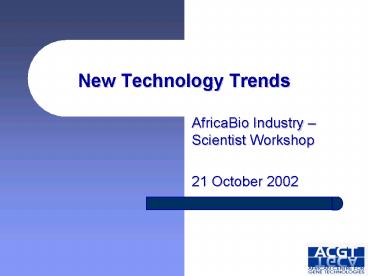New Technology Trends - PowerPoint PPT Presentation
1 / 22
Title:
New Technology Trends
Description:
Metabolic State. Stress. Culture. Conditions. Genome. Developmental. Stage ... is wearing them, what they are doing, and will monitor their physiological state ... – PowerPoint PPT presentation
Number of Views:77
Avg rating:3.0/5.0
Title: New Technology Trends
1
New Technology Trends
- AfricaBio Industry Scientist Workshop
- 21 October 2002
2
Sequencing the genome is just the beginning!
3
(No Transcript)
4
From Sequence to Function
Genome sequencing
30-40 000 genes in the human genome Less than 2
of the genome codes for proteins
Functional genomics
How do genes function and how are they regulated
Transcriptomics
Study of genes expressed through mRNA
Comparative genomics
Comparison of DNA between organisms
Structural genomics
3-D structures of proteins from all protein
families
Proteomics
Study of all the expressed proteins
Study of all the metabolites in an organism
Metabolomics
5
One genotype two phenotypes!
6
Transcriptomics DNA microarrays
- Microscopic spots, consisting of
oligonucleotides, or cDNA molecules, - are immobilised on a solid support
- Parallel assessment of 1000s of genes in a
single experiment - Uses transcript monitoring and large scale
genotyping
7
Deposition DNA microarrays
8
The proteome as a biological sensor
9
Applications of proteomics
- Comparison of normal and diseased tissues
- Identification of diagnostic or predictive
markers - Identification of potential drug targets
- Investigation of disease mechanisms
- Comparison of control and treated cells
- Investigation of biochemical pathways
- Elucidation of pharmacological mechanisms
- Toxicology prediction of potential side-effects
- Determination of dose-response relationships
- Process optimization
10
A Proteomics Laboratory
Digested material is then cleaned up and placed
onto instrument sample plate.
Spots(Proteins) in tubes mounted in plate - are
digested and placed into new plate.
MALDI-TOF Instrument
Samples
2d Gels
Mass spectrum
2d Gel processed to remove spots -manually or
automatically using a spot picker. Spots placed
in individual tubes and placed into plate layout
Instrument sample plate
11
Protein chip technology
- Proteins deposited in microarrays similar to DNA
microarrays - Use to measure protein-protein interactions
- Eg Screen a blood sample for reactivity to a
range of protein allergens - Investigate how disease develops, how drugs work
and how to find new drugs
12
Beyond biotechnology working across boundaries
- Biotechnology materials science interface
- Biotechnology IT interface
- Biotechnology electronics interface
- Biotechnology environment interface
13
Biosensors
- Incorporate a biological element such as an
enzyme, antibody, nucleic acid, microorganism or
cell. - Compact analytical device incorporating a
biological or biologically-derived sensing
element either integrated within or intimately
associated with a physicochemical transducer. - Aim is to produce either discrete or continuous
digital electronic signals which are proportional
to a single analyte or a related group of
analytes
14
Biosensors in the environment
- Genetically engineered bacteria glow in the
presence of toluene, a hazardous compound found
in gasoline and other petroleum products. - They can indicate whether an underground fuel
tank is leaking or whether the site of an oil
spill has been cleaned up effectively. - Other bacteria glow in the presence of poisons,
explosives or pollutants - They can detect the presence of cancer causing
agents in groundwater - Biosensors can detect the presence of biological
and chemical warfare agents and determine the
effectiveness of cleaning up waste sites.
15
Multiplexed Immunosensors
- Microspheres of different sizes are labeled with
antibodies that bind to different bacteria. The
sizes of the microspheres are identified by laser
resonance. Up to 100 different types of bacteria
can be identified simultaneously. - Applications in food safety and food quality,
diagnostics etc
16
Intelligent clothing
- Biosensors incorporated into clothing
- Clothes will know who is wearing them, what they
are doing, and will monitor their physiological
state - Clothing will send a signal,
- eg advising sportsmen of
- metabolic status
17
Biosensors in medicine
- Personal diagnostics - embed biosensors in a
miniature microfluidics-based micro-device with
dimensions similar to that of a credit card. This
device will emit a signal following exposure to
chemicals or other bodily fluid. The signal can
be detected by a hand held detection system.
18
Calcium ion detector
A sensitive detector for monitoring changes in
the body's concentrations of calcium ions. This
biosensor consists of an optical fiber to which
is attached a synthesized hybrid molecule. One
half of the hybrid molecule binds calcium ions
and the other half fluoresces when calcium ions
are bound to the molecule. Similar techniques
can be applied to measurement of other bodily
functions
19
Biomaterials
- Joint replacements, spinal implants, and bone
fixators cardiac implants such as artificial
heart valves and pacemakers soft tissue implants
such as breast implants and injectable collagen
for soft tissue augmentation and dental implants - Future biomaterials will incorporate biological
factors (such as bone growth) directly into an
implants surface to improve biocompatibility and
bioactivity.
20
Biopolymers
- Non-toxic and biodegradable products
- Packaging, food production and medicine
- Adhesives, fibres and films
- Detergents, coating, personal care products
- Dispersants, anti-scalants, corrosion inhibitors
etc - Spider silk protein
- May be based on proteins, polysaccharides,
polyphenolics, polyesters etc
21
Biological computers
- The world's first programmable biological
computer is so small that a billion of them can
fit in a single drop of water. - Bacteriorhodopsin based computer memories can be
integrated into electronic computers - Cultured living neuronal cells may be linked to
form computers - DNA computers may be ideal for applications
requiring non-deterministic (massively parallel)
computing
22
The challenge for South Africa
- How do we adapt and adopt the new technologies
for our own circumstances? - How do we ensure that we are not left behind the
rest of the world? - How do we identify niche opportunities where we
can be world leaders?































